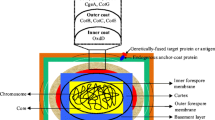Abstract
Spores from severalBacillus species displayed a strong affinity for hexadecane and other hydrophobic solvents. The binding ofBacillus subtilis spore suspensions to octyl-Sepharose was enhanced by ammonium sulfate and other salts, but was inhibited by detergents. Treatment of spore suspensions with strong denaturants promoted their adherence to hexadecane, presumably by exposing hydrophobic residues in coat proteins. The hydrophobic characteristics of spores may be important in the ecological adaptation of certain bacteria.
Similar content being viewed by others
Literature Cited
Boyles, W. A., Lincoln, R. E. 1958. Separation and concentration of bacterial spores and vegetative cells by foam flotation. Applied Microbiology6:327–334.
Cole, H., Ezzell, J., Keller, K. F., Doyle, R. J. 1984. Differentiation ofBacillus anthracis and otherBacillus species by lectins. Journal of Clinical Microbiology19:48–53.
Doyle, R. J., Nesbitt, W. E., Taylor, K. G. 1983. On the mechanism of adherence ofStreptococcus sanguis to hydroxylapatite. Federation of European Microbiological Societies Letters15:1–5.
Hjerten, S. 1978. Fractionation of membrane protein by hydrophobic interaction chromatography and by chromatography on agarose equilibrated with a water-alcohol mixture of low or high pH. Journal of Chromatography159:85–91.
Jenkinson, H. F., Lord, H. 1983. Protease deficiency and its association with defects in spore coat structure, germination, and resistance properties in a mutant ofBacillus subtilis. Journal of General Microbiology129:2727–2737.
Jonsson, P., Wadstrom, T. 1983. High surface hydrophobicity ofStaphylococcus aureus as revealed by hydrophobic interaction chromatography. Current Microbiology8:347–353.
Krieg, N. R. 1981. Enrichment and isolation, pp. 112–142. In: Gerhardt, P., Murray, R. G. E., Costilow, R. N., Nester, E. W., Wood, W. A., Krieg, N. R., Phillips, G. B. (eds.), Manual of methods for general bacteriology. Washington, DC: American Society for Microbiology.
Lindahl, M., Faris, A., Wadstrom, T., Hjerten, S. 1981. A new test based on “salting out” to measure relative surface hydrophobicity of bacterial cells. Biochimica et Biophysica Acta677:471–476.
Miorner, H., Johansson, G., Kronvall, G. 1983. Lipoteichoic acid is the major cell wall component responsible for surface hydrophobicity of group A streptococci. Infection and Immunity39:336–343.
Mobley, H. L. T., Doyle, R. J., Jolliffe, L. K. 1983. Cell wall-polypeptide complexes inBacillus subtilis. Carbohydrate Research116:113–125.
Murrell, W. G. 1981. Biophysical studies on the molecular mechanisms of spore heat resistance and dormancy, pp. 64–77. In: Levinson, H. S., Sonenshein, A. L., Tipper, D. J. (eds.), Sporulation and germination. Washington, DC: American Society for Microbiology.
Nesbitt, W. E., Doyle R. J., Taylor, K. G. 1982. Hydrophobic interactions and the adherence ofStreptococcus sanguis to hydroxylapatite. Infection and Immunity38:637–644.
Ofek, I., Simpson, W. A., Beachey, E. H. 1982. Formation of molecular complexes between a structurally defined M protein and acylated and deacylated lipoteichoic acid ofStreptococcus pyogenes. Journal of Bacteriology149:426–433.
Rosenberg, M., Gutnick, D., Rosenberg, E. 1980. Adherence of bacteria to hydrocarbons: a simple method for measuring cell-surface hydrophobicity. Federation of European Microbiological Societies Letters9:29–33.
Rosenberg, M., Bayer, E. A., Delarea, J., Rosenberg, E. 1982. Role of thin fimbriae in adherence and growth ofAcinetobacter calcoaceticus on hexadecane. Applied and Environmental Microbiology44:929–937.
Shaltiel, S. 1974. Hydrophobic chromatography. Methods in Enzymology34:126–140.
Tylewska, S. K., Hjerten, S., Wadstrom, T. 1979. Contribution of M protein to the hydrophobic surface properties ofStreptococcus pyogenes. Federation of European Microbiological Societies Letters6:249–253.
Warth, A. D. 1978. Molecular structure of the bacterial spore. Advances in Microbial Physiology17:1–45.
Watt, I. C. 1981. Water vapor adsorption byBacillus stearothermophilus endospores, pp. 253–255. In: Levinson, H. S., Sonenshein, A. L., Tipper, D. J. (eds.) Sporulation and germination. Washington, DC: American Society for Microbiology.
Author information
Authors and Affiliations
Rights and permissions
About this article
Cite this article
Doyle, R.J., Nedjat-Haiem, F. & Singh, J.S. Hydrophobic characteristics ofBacillus spores. Current Microbiology 10, 329–332 (1984). https://doi.org/10.1007/BF01626560
Issue Date:
DOI: https://doi.org/10.1007/BF01626560




